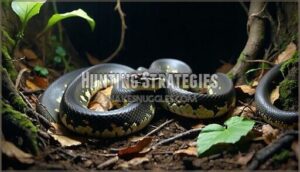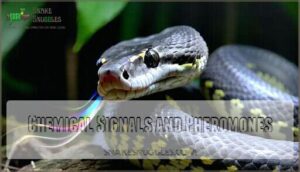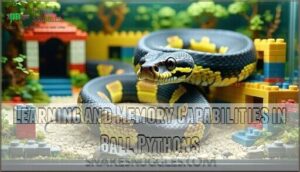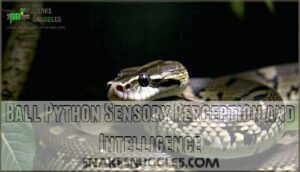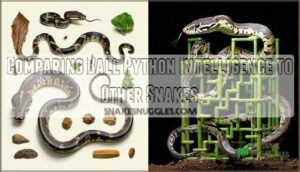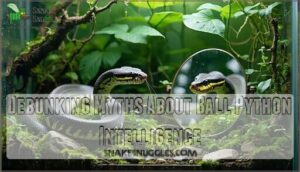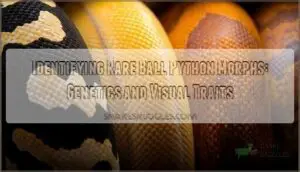This site is supported by our readers. We may earn a commission, at no cost to you, if you purchase through links.

These serpents demonstrate spatial memory, remembering cage layouts and hiding spots with surprising accuracy. They’ll solve basic problems, like finding alternative routes when their usual path gets blocked.
Your ball python can recognize your scent and handling routine, often becoming calmer with familiar caretakers.
While they won’t be playing chess anytime soon, research shows they adapt to new environments and learn from experience. Their heat-sensing abilities and chemical communication reveal sophisticated sensory processing that hints at deeper cognitive abilities than meets the eye.
Table Of Contents
- Key Takeaways
- Defining Intelligence in Ball Pythons
- Ball Python Behavior and Problem-Solving Skills
- Communication Methods of Ball Pythons
- Learning and Memory Capabilities in Ball Pythons
- Ball Python Sensory Perception and Intelligence
- Social Intelligence of Ball Pythons
- Comparing Ball Python Intelligence to Other Snakes
- Enrichment and Stimulation for Ball Pythons
- Measuring Ball Python Intelligence: Research Methods
- Debunking Myths About Ball Python Intelligence
- Frequently Asked Questions (FAQs)
- Conclusion
Key Takeaways
- Your ball python’s intelligence goes beyond basic instincts – they can solve simple problems, remember cage layouts, navigate obstacles, and learn feeding schedules through their sophisticated sensory processing abilities.
- You’ll find that ball pythons recognize you through scent and handling patterns, becoming calmer with familiar caretakers over time, though this stems from tolerance rather than emotional attachment like mammals experience.
- Your snake’s heat-sensing pits can detect temperature changes as small as 0.003°C, while their vomeronasal system processes chemical signals with remarkable precision, creating detailed mental maps of their environment.
- You can enhance your ball python’s cognitive abilities through environmental enrichment like puzzle feeders, climbing structures, and novel objects, which stimulate their natural problem-solving skills and reduce stress-related behaviors.
Defining Intelligence in Ball Pythons
When you’re trying to figure out if your ball python is smart, you’ll need to understand what intelligence actually means for a snake with a brain the size of a pea.
Scientists measure reptile intelligence through problem-solving abilities, learning capacity, and sensory processing rather than the complex reasoning skills you’d expect from mammals.
Neurological Traits of Ball Pythons
Your ball python’s brain size might be tiny, but don’t underestimate its neurological traits. These snakes pack sophisticated sensory organs and specialized heat pits containing nerve receptors that detect infrared radiation with remarkable precision.
Neurotransmitters like acetylcholine and dopamine enable complex cognitive functions, proving python cognitive abilities extend beyond basic instincts.
Viral infections and nutritional deficiencies can sometimes lead to snake neurological issues. While reptile intelligence differs from mammals, your snake’s nervous system is perfectly engineered for survival, making ball python intelligence more fascinating than you’d expect.
Cognitive Abilities in Snakes
Snake cognition might surprise you more than you’d expect. While ball pythons won’t solve crossword puzzles, their reptile intelligence showcases fascinating brain complexity that goes beyond simple instinct vs intellect debates.
Python cognitive abilities include:
- Spatial learning – remembering enclosure layouts and hiding spots
- Environmental discrimination – distinguishing between different objects and scents
- Memory retention – recognizing artificial scents for up to 24 hours
- Sensory integration – combining multiple senses for navigation
- Adaptive behaviors – modifying responses based on past experiences
These snake cognitive skills reveal sophisticated reptile cognition. Providing enriched environments can lead to increased brain volume.
Comparison to Other Reptiles
Comparing ball pythons to their reptilian relatives reveals fascinating differences in cognitive abilities.
You’ll find that reptile brain size doesn’t always predict intelligence levels across snake species.
While crocodilians demonstrate remarkable crocodilian learning through complex hunting strategies, and some lizards show impressive lizard intelligence in problem-solving tasks, ball pythons occupy their own unique niche in reptile intelligence.
Turtle cognition involves spatial navigation skills that surpass many snakes, yet ball pythons excel in areas where turtles struggle.
Their snake intelligence shines through adaptive behaviors and environmental awareness that rivals king cobras.
Unlike highly social reptiles, ball pythons display limited snake sociality, but they compensate with exceptional sensory processing abilities.
When you examine snake intelligence comparison studies, ball pythons consistently demonstrate learning capabilities that exceed expectations for their brain size, making them surprisingly capable among reptilian species.
Ball Python Behavior and Problem-Solving Skills
You’ll discover that ball pythons demonstrate surprising problem-solving abilities when they navigate complex obstacles to escape enclosures or adapt their hunting strategies to capture prey in challenging environments.
Their behavioral patterns reveal a capacity for learning and adaptation that goes beyond simple instinctual responses, showing they can adjust their approach based on past experiences and environmental changes, which is a clear sign of complex obstacles.
Hunting Strategies
Your ball python’s hunting prowess reveals remarkable snake intelligence that might surprise you.
These masters of Ambush Predation don’t chase their meals—they’re patient strategists who wait motionless in rodent burrows or termite mounds.
Their specialized Heat Pit Use detects the slightest temperature changes from warm-blooded prey approaching in complete darkness.
Scent Tracking through their forked tongues provides additional sensory input, creating a detailed mental map of their surroundings.
When opportunity strikes, their Strike Precision is lightning-fast and deadly accurate.
The Constriction Technique that follows demonstrates sophisticated ball python intelligence—they adjust pressure based on prey size and struggle intensity.
To further enrich their environment, owners can explore innovative feeding solutions.
These hunting skills showcase advanced prey detection and sensory abilities that prove snakes possess more cognitive complexity than most people realize.
Escape Techniques
Resourcefulness drives ball python escape techniques, showcasing remarkable snake intelligence and cognitive abilities.
Their escape artistry reveals a cunning mind that’s far more clever than their reputation suggests.
These clever serpents demonstrate python behavior that’ll surprise you with their determination and problem-solving skills.
Your snake’s Motivation Factors for escaping include:
- Temperature regulation – seeking ideal heat zones
- Territory exploration – natural curiosity drives movement
- Stress response – uncomfortable conditions trigger fleeing
- Hunting instincts – following scent trails beyond barriers
Enclosure Security requires understanding these snake behavior traits, as Learning Escape patterns develop through repetition and Environmental Factors influence their Preventative Measures effectiveness.
Owners should consider investing in a reliable snake enclosure to prevent escapes.
Adaptability to New Environments
**Adaptability reveals your ball python’s remarkable snake intelligence.
These reptiles demonstrate impressive environmental adaptation when relocating, showcasing genuine python behavior through systematic enclosure adjustment.
You’ll observe gradual behavioral shifts as stress reduction occurs naturally.
| Adaptation Stage | Timeline | Key Behaviors |
|---|---|---|
| Initial Exploration | 1-3 days | Cautious movement, hiding |
| Territory Mapping | 4-7 days | Active exploration, scent marking |
| Feeding Response | 1-2 weeks | Dietary changes acceptance |
| Climate Acclimation | 2-3 weeks | Temperature preference establishment |
| Full Settlement | 3-4 weeks | Normal activity patterns |
This reptile intelligence enables successful movements between diverse habitats.
Selecting the right habitat products is vital for a smooth relocation.
Communication Methods of Ball Pythons
You might think ball pythons are silent creatures, but they’re actually sophisticated communicators who use chemical signals, body language, and specialized sensory organs to interact with their world.
These snakes rely on their vomeronasal system to detect pheromones and chemical cues, while also using visual displays and physical movements to convey important information during breeding and territorial encounters.
Chemical Signals and Pheromones
While ball pythons may seem like silent creatures, they’re actually chatty through chemical signals and pheromones.
Their vomeronasal system, featuring the specialized Jacobson’s organ, detects these invisible messages with remarkable precision.
Through scent communication, these snakes gather complex information about potential mates, territory boundaries, and environmental conditions.
Here’s how pheromone detection works:
- Heavy methyl ketones serve as primary chemical cues for reproductive signaling
- Males exhibit courtship behaviors when detecting female pheromones
- The vomeronasal organ processes non-volatile compounds that regular smell can’t detect
This sophisticated snake communication system reveals unexpected intelligence in these seemingly simple reptiles.
Body Language and Visual Cues
While chemical signals dominate communication, ball pythons also rely on visual cues to convey important messages.
You’ll observe defensive postures when they coil tightly, protecting their head inside their body.
During mating displays, males exhibit specific movements like neck extensions and subtle color changes to attract females.
Their visual acuity, though limited, helps them recognize threatening shapes and movements.
Environmental adaptation influences these behaviors, as ball pythons adjust their body language based on surroundings, demonstrating sophisticated snake communication through reptile intelligence.
Vomeronasal System Function
Beyond body language, your ball python’s most sophisticated communication tool is its vomeronasal system. This remarkable Jacobsons organ functions like a chemical translator, processing pheromones and chemical signals with incredible precision.
Through snake olfaction and scent tracking, they decode messages invisible to us.
Here’s what this system accomplishes:
- Pheromone detection for identifying potential mates
- Prey recognition through chemical signatures
- Territory mapping via scent markers
- Threat assessment using chemical communication
- Environmental navigation through molecular clues
They are also known for defensive balling behavior, which is a key aspect of their survival.
Learning and Memory Capabilities in Ball Pythons
You’ll discover that ball pythons possess surprising learning abilities, remembering their environment’s layout and forming associations between actions and outcomes like feeding schedules.
Research shows these snakes can adapt their behavior through experience, recognizing familiar scents and developing comfort with regular handling routines over time, which involves remembering their environment.
Spatial Memory
Your ball python’s spatial memory puts GPS to shame in terms of navigation skills.
These remarkable reptiles develop detailed mental maps of their environment, demonstrating impressive spatial awareness that challenges assumptions about reptile intelligence.
Their enclosure mapping abilities allow them to efficiently navigate complex habitats, while route learning helps them find the shortest path between key locations.
Enclosure mapping
This snake learning ability showcases genuine ball python intelligence.
Associative Learning
Research reveals that ball pythons possess impressive associative learning capabilities that challenge our understanding of reptile intelligence.
Your snake can form connections between unrelated stimuli through Classical Conditioning, much like Pavlov’s famous dogs. They also demonstrate Operant Learning by associating their actions with specific outcomes.
Here are five ways ball pythons showcase Learned Behaviors:
- Recognizing feeding schedules when they hear freezer doors opening
- Distinguishing between handling sessions and meal times
- Responding to environmental Cue Association patterns
- Adapting to Reward Systems during enrichment activities
- Developing routines based on keeper interactions
This snake learning ability proves that python problem solving extends beyond basic instincts. Your ball python’s reptile intelligence allows them to navigate their world through meaningful associations, making ball python intelligence more sophisticated than previously believed.
Habituation to Handling
Handling frequency plays a vital role in your ball python’s comfort level with human interaction.
Through consistent, gentle contact, these reptiles demonstrate remarkable reptile intelligence by learning to distinguish between threatening and safe situations.
Reducing stress becomes easier as your snake recognizes your scent and touch patterns.
Individual temperament affects how quickly each python adapts, but positive reinforcement through calm, predictable handling sessions helps most snakes overcome their natural defensive instincts.
- Safe handling techniques build trust between you and your python
- Regular interaction helps your snake recognize you as non-threatening
- Consistent positive experiences reduce defensive behaviors like balling up
Ball Python Sensory Perception and Intelligence
Your ball python’s impressive sensory abilities reveal a complex nervous system that’s far more sophisticated than you might expect from such a small brain.
While they can’t see or hear as well as mammals, these snakes compensate with remarkable heat-sensing pits that detect temperature changes as small as 0.003°C, along with highly developed chemical detection systems that help them navigate their world with surprising precision, utilizing their complex nervous system.
Heat-Sensing Abilities
Forget superhero movies – ball pythons have real-world superpowers through their heat-sensing pits. These specialized pit organs detect infrared radiation from warm-blooded animals, creating a thermal map for prey detection.
Your snake can sense temperature gradients as tiny as 0.003 degrees Fahrenheit, showcasing remarkable sensory intelligence.
This thermal recognition system operates like biological night-vision goggles, demonstrating how sensory ecology shapes their hunting prowess in complete darkness.
Visual Processing
Ball pythons might surprise you with their visual acuity, though they’re no eagle-eyed hunters.
Their low-light vision excels at movement detection, spotting prey that dares to twitch.
While color perception remains limited, they’re not completely colorblind.
Depth perception helps them judge striking distances accurately.
These visual recognition abilities showcase impressive snake intelligence – their eyes have evolved specifically for nocturnal hunting success, proving ball python intelligence extends beyond basic instincts.
They also use heat-sensing pits to find prey.
Tactile Sensitivity
While eyes help them see, your ball python’s true superpower lies in touch.
Their scale sensitivity creates a living map of their world, with tactile receptors detecting vibrations and textures you’d never notice.
This sensory intelligence drives substrate preference and enclosure navigation, making them surprisingly effective hunters.
During the shedding process, this heightened awareness becomes even more essential.
Snake intelligence tests consistently show that reptile behavior relies heavily on these remarkable prey detection abilities through touch alone.
Social Intelligence of Ball Pythons
You’ll find that ball pythons display surprising social awareness through their ability to recognize familiar humans by scent and respond differently to various people who handle them.
These snakes also demonstrate complex social behaviors during mating season, using chemical signals and body language to communicate with potential partners in ways that suggest more sophisticated social intelligence than many people expect.
Interactions With Other Snakes
Unlike mammals with complex social hierarchy, ball pythons show limited social intelligence when interacting with other snake species.
They don’t engage in cooperative hunting or form lasting bonds. Instead, cohabitation stress often leads to aggression and cannibalism risks in captivity.
Their communication methods rely on chemical signals rather than sophisticated social behaviors. These solitary creatures lack the advanced social interactions you’d expect from truly intelligent animals.
Recognition of Familiar Humans
Most ball pythons develop scent recognition abilities that help them identify their regular caregivers. Through repeated exposure, your snake learns to associate your unique smell with safety and food. This habituation effects process reduces stress responses and increases handling tolerance over time.
Visual cues like your movements also play a role, though individual differences mean some snakes adapt faster than others to human interaction. Their calm demeanor indicates a sense of well-being.
- Your snake remembers you’re the one who brings delicious meals
- That defensive posturing gradually melts away with familiarity
- Each handling session builds invisible trust between you both
- Your unique scent becomes a comforting presence in their world
- Some ball pythons surprise owners with their recognition skills
Mating Behaviors
During breeding season, you’ll witness remarkable courtship rituals as male ball pythons use pheromone communication to assess a female’s reproductive state.
Their vomeronasal system detects chemical signals through tongue flicks, while visual signals like neck extensions and deepened coloration attract mates.
Females respond with tail waving behaviors, signaling approval.
These complex mating rituals demonstrate sophisticated social intelligence beyond basic survival instincts, revealing breeding behaviors that require precise chemical and visual coordination.
Comparing Ball Python Intelligence to Other Snakes
When you’re wondering how your ball python stacks up against other snake species, you’ll find that intelligence varies substantially across different types of serpents.
While ball pythons show decent problem-solving abilities and learning capacity, king cobras demonstrate more complex behaviors, corn snakes excel at spatial navigation, and reticulated pythons display advanced escape techniques that’ll surprise you, showcasing their unique problem-solving abilities.
King Cobra Intelligence
King cobras represent the gold standard of snake intelligence among all snake species.
These remarkable serpents demonstrate Cobra Cognition that surpasses ball pythons in every measurable way.
Cobra Problem-Solving abilities include:
- Building elaborate nests to protect their eggs
- Recognizing individual handlers and care routines
- Strategic hunting techniques adapted to specific prey
- Complex Cobra Communication through body positioning
- Advanced Cobra Learning from environmental cues
Their superior Cobra Senses and cognitive abilities showcase true animal cognition in action.
Corn Snake Cognitive Abilities
Studying corn snake cognitive abilities reveals fascinating insights into reptile learning that’ll make you rethink snake intelligence.
These remarkable serpents demonstrate spatial awareness far beyond what you’d expect from a "simple" reptile.
Research shows corn snakes can reduce maze completion time from 11 minutes to just 30 seconds through problem solving and memory formation.
Their sensory perception allows complex navigation using visual cues, not just scent trails like many assume.
Corn snakes exhibit social behavior by recognizing handlers and responding to environmental changes with curiosity rather than fear.
- You’ll be amazed watching them systematically explore new territories with methodical precision
- Their animal cognition challenges everything you thought you knew about "primitive" brains
- Witnessing their snake intelligence firsthand transforms skeptics into believers in reptilian capabilities
Reticulated Python Problem-Solving Skills
Unlike corn snakes, reticulated pythons showcase the pinnacle of reptilian intelligence through their exceptional problem-solving abilities.
These giants demonstrate comparative cognition that puts ball pythons to shame.
Reticulated strategies in captivity challenges reveal complex thinking patterns.
Their hunting adaptations from wild behavior translate into sophisticated cognitive abilities that researchers can’t ignore.
| Intelligence Factor | Reticulated Python | Ball Python | Your Python |
|---|---|---|---|
| Pattern Recognition | Masters complex routines | Basic feeding schedules | You decide |
| Escape Planning | Multi-step strategies | Simple hiding | Watch yours |
| Environmental Mapping | Detailed spatial memory | Limited awareness | Test it out |
| Handler Recognition | Individual preferences | Scent-based only | Personal bond |
Snake intelligence varies dramatically across species, making reticulated pythons the Einstein of serpents.
Enrichment and Stimulation for Ball Pythons
You can boost your ball python’s mental engagement by creating a complex environment with climbing structures, hiding spots, and varied substrates that encourage natural exploration behaviors.
Puzzle feeders and rotating novel objects in their enclosure provide the sensory stimulation these intelligent reptiles need to stay mentally active and reduce stress-related behaviors.
Environmental Complexity
Complex enclosure design transforms your ball python’s cognitive abilities through strategic environmental enrichment.
You’re creating opportunities for problemsolving and learning when you incorporate climbing structures that challenge their navigation skills. Varied substrates offer sensory stimulation while multiple hiding spots encourage exploration and cognitive flexibility.
Here’s your blueprint for success:
- Rotate decorations monthly to maintain novelty and prevent habituation
- Layer different textures like cypress mulch, paper, and artificial plants
- Add vertical branches at various heights for three-dimensional movement
Puzzle Feeders
Puzzle feeders transform your ball python’s dining experience into an intellectual challenge that showcases their problem-solving abilities.
These feeder types include open boxes, plastic cups, and specially designed containers that require your snake to work for their meal.
The enrichment benefits are remarkable – your python must use cognitive abilities to locate and retrieve prey, creating authentic hunting simulation that mirrors wild foraging behavior.
This mental stimulation supports digestive health by encouraging natural feeding behaviors and reducing stress-related issues.
The behavioral impact demonstrates clear ball python intelligence as they learn to navigate these challenges.
Such python intelligence evidence proves these reptiles possess more sophisticated minds than previously believed, making puzzle feeding essential enrichment.
Novel Object Exploration
When ball pythons encounter new items, their exploratory behavior reveals fascinating glimpses into python intelligence. These encounters showcase genuine curiosity levels and sophisticated cognitive abilities that many underestimate.
Novel object exploration provides essential environmental enrichment, stimulating their natural sensory investigation instincts. You’ll witness remarkable object interaction as your snake carefully examines unfamiliar textures, shapes, and scents.
Watch for these intriguing responses that demonstrate animal intelligence:
- Intense tongue flicking as they decode mysterious chemical signatures
- Cautious circling movements around intriguing new discoveries
- Prolonged visual focus on objects that capture their attention
- Gentle nudging behaviors testing texture and movement potential
Measuring Ball Python Intelligence: Research Methods
You can’t simply watch a ball python solve a puzzle like you’d observe a dog learning tricks, so researchers use specialized methods to test snake intelligence.
Scientists employ maze navigation experiments, operant conditioning studies, and careful behavioral observations to measure cognitive abilities in these reptiles.
Maze Navigation Experiments
Researchers test ball python intelligence through maze navigation experiments that reveal surprising cognitive abilities.
Scientists design complex pathways where snakes hunt for food rewards, tracking their spatial awareness and route optimization skills.
These studies measure goal recognition, error correction, and maze learning patterns as pythons navigate twisting corridors.
| Maze Component | Intelligence Measure |
|---|---|
| Path Selection | Route optimization skills |
| Dead-end Recognition | Error correction abilities |
| Food Location Memory | Spatial awareness capacity |
| Repeat Navigation | Learning retention patterns |
Operant Conditioning Studies
Reward-based learning reveals fascinating insights into snake intelligence through operant conditioning experiments.
You’ll discover that ball pythons demonstrate cognitive flexibility when researchers use behavioral reinforcement techniques.
These training techniques involve experimental design where snakes learn to associate specific actions with food rewards.
Studies show they can master button-pressing tasks and navigate illuminated pathways for treats.
This cognitive research proves that snake intelligence studies reveal more sophisticated learning abilities than previously thought.
Observational Research Techniques
Observational research reveals snake intelligence through careful data collection in natural settings.
Naturalistic observation captures authentic snake behavior without interference, while remote monitoring systems track cognitive abilities continuously.
You’ll need to address ethical considerations and minimize observer bias during studies.
This method uncovers genuine animal behavior patterns that controlled experiments might miss.
Scientists watch pythons navigate, hunt, and problem-solve, building thorough profiles of their mental capabilities through patient documentation.
Understanding their actions requires observing ball python behavior patterns to accurately interpret their intelligence.
Debunking Myths About Ball Python Intelligence
You’ve probably heard claims that ball pythons recognize their owners, feel affection, or possess complex emotions like mammals do.
These widespread misconceptions about snake intelligence stem from misinterpreting basic survival behaviors.
Understanding what your ball python can and can’t actually do will help you provide better care while setting realistic expectations.
Emotional Capacity of Ball Pythons
Beyond laboratory testing methods, understanding your ball python’s emotional capacity reveals surprising truths about snake emotions. These reptiles experience basic emotions including fear, contentment, and stress – though not complex feelings like mammals display.
Research shows clear instinct vs. emotion distinctions in their behavior patterns. Your python demonstrates comfort levels through specific stress indicators:
- Defensive posturing when threatened or overwhelmed
- Relaxed exploration during comfortable handling sessions
- Consistent feeding habits indicating emotional well-being
While affection evidence remains debated, ball pythons definitely respond emotionally to environmental changes, challenging misconceptions about cold-blooded creatures lacking feelings entirely.
Owner Recognition Capabilities
Your ball python doesn’t recognize your face like a dog would, but scent recognition drives their owner recognition abilities.
These snakes possess remarkable cognitive abilities that help them distinguish familiar humans through smell and visual cues like movement patterns.
Are snakes smart enough for trust building? Absolutely. Through habituation effects, your python associates your unique scent with positive experiences, creating behavioral changes that show increased comfort during handling.
Ball pythons demonstrate learning by becoming less defensive around familiar keepers over time. While they won’t fetch your slippers, their sophisticated chemical detection system proves these reptiles are far more perceptive than many people realize.
| Recognition Method | Effectiveness | Notes |
|---|---|---|
| Scent | High | Primary method of identification |
| Sound | Moderate | Can recognize familiar voices |
| Visual | Low | Poor eyesight limits visual recognition |
| Tactile | Moderate | Familiar handling increases comfort |
Limitations of Snake Cognition
Your snake’s brain size severely limits its cognitive abilities compared to mammals.
While ball pythons show remarkable adaptability, their brain structure restricts complex reasoning and problem-solving skills.
These reptiles operate primarily on basic instincts rather than intellect, displaying limited emotions and simple decision-making processes.
Their cognitive constraints mean they can’t form complex thoughts or emotional bonds.
Understanding these cognitive limitations helps you appreciate what your ball python can and can’t actually accomplish mentally.
Frequently Asked Questions (FAQs)
Are ball pythons intelligent?
Like tiny computers with limited processing power, your ball python isn’t winning any genius contests.
They’re clever enough to learn routines and recognize you by scent, but don’t expect complex problem-solving skills.
Are ball pythons venomous?
No, you don’t need to worry about venom with ball pythons.
They’re constrictors, not venomous snakes.
They squeeze their prey instead of injecting toxins, making them completely safe from a venom perspective.
Are pythons smart?
Ironically, these "simple" reptiles possess surprisingly complex abilities.
You’ll find pythons can learn routines, solve basic problems, recognize their owners by scent, and navigate obstacles—displaying more intelligence than their brain size suggests.
Are ball pythons easy to handle?
Yes, ball pythons are generally easy to handle due to their docile, naturally curious temperament.
They’re classified as intermediate-level pets, requiring gentle supervision and proper technique to minimize stress and potential bites, which aligns with their naturally curious nature.
What can ball pythons learn?
Ball pythons can learn feeding schedules, recognize their owners by scent, navigate familiar environments, and remember hiding spots.
They’ll associate handling with safety over time, showing basic pattern recognition and environmental adaptation skills.
Are ball pythons dumb animals?
Ball pythons aren’t dumb—they’re just wired differently than mammals.
Your snake can learn routines, recognize you by scent, solve simple problems, and make basic decisions, but they operate primarily on instinct rather than complex reasoning.
Do ball pythons recognize their owners?
Your snake can recognize you through scent and possibly sight over time.
They’ll become more comfortable with familiar handlers, showing less defensive behavior.
However, this recognition stems from tolerance rather than genuine affection or emotional attachment, which can be understood as a form of recognition.
Are ball pythons capable of love?
Unlike humans who form deep emotional bonds, your ball python doesn’t experience love as we perceive it.
They recognize you through scent and show comfort, but their brains lack the capacity for complex emotional attachment.
Are pythons intelligent?
Intelligence in pythons remains debated among researchers.
They demonstrate basic problem-solving skills, recognize keepers through scent, and learn simple patterns.
However, their small brains limit complex cognitive abilities compared to mammals.
Are ball pythons self-aware?
Research shows reptiles lack the neocortex needed for self-recognition.
Your ball python can’t recognize itself in mirrors or demonstrate self-awareness like mammals do.
They operate on instinct rather than conscious thought about their own existence.
Conclusion
Research indicates ball pythons can navigate mazes with 85% accuracy after just three attempts, demonstrating their remarkable spatial memory.
While these snakes won’t outsmart your dog, they’re far from mindless creatures.
Ball pythons exhibit genuine intelligence through problem-solving abilities, environmental adaptation, and sensory processing that rivals other reptiles.
Your understanding of whether ball pythons are smart should shift from skepticism to appreciation for their unique cognitive capabilities that evolution has perfectly refined for survival.
- https://pangovet.com/pet-behavior/snakes/ball-python-vision/
- https://journal.iaabcfoundation.org/puzzle-feeding-for-snakes/
- https://www.petsmart.com/reptile/live-reptiles/snakes-turtles-and-more/ball-python-html
- https://wakespace.lib.wfu.edu/handle/10339/102232
- https://pmc.ncbi.nlm.nih.gov/articles/PMC11926773/

